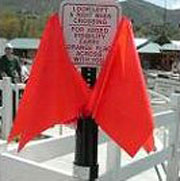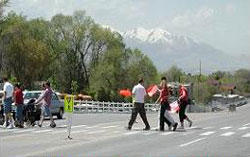Crosswalk Flags and the Adopt-a-Crosswalk Program
Salt Lake City, Utah
Source: Pedestrian and Bicycle Information Center (PBIC)

Flags used in the program.
Problem
Motorists' inability to see pedestrians crossing at various road and crosswalk types created an unsafe environment for pedestrians.
Background
The Mayor of Salt Lake City in 2000, Rocky Anderson, responded to a national study that declared Salt Lake City as "not pedestrian friendly" by creating a Pedestrian Safety Committee aimed at reducing pedestrian injury accidents. The committee implemented several different safety measures, including crosswalk flags and the Adopt-a-Crosswalk Program.
Solution
Removable orange flags were installed at crosswalks to increase drivers' visibility of pedestrians. The flags increased visibility and showed a clear indication of pedestrians' desire to cross the street. It was shown that both pedestrians and drivers thought there was a benefit of the simple presence of the flags in their holders at the crosswalk. Pedestrians take the flags from one end of the crosswalk to increase their visibility as they cross the street and then return them to the other holder.

Pedestrians cross the street using flags to increase visibility.
Six initial crosswalks were outfitted with flags in August of 2000. By 2007 there were 40 city-maintained downtown flag locations. Due to the lack of available funds and an increased demand of crosswalks with flags, the city began an Adopt-a-Crosswalk program in January 2001. The Adopt-a-Crosswalk program allows individuals or businesses within a one block radius of a marked crosswalk to "adopt" the crosswalk. This program requires that the sponsor monitors the flags and purchases replacement flags when needed. The city installs the flag holders and usage signs, and provides the initial supply of flags at no cost; replacement flags are available for $0.50 each.
City ordinances were also modified to increase penalties for drivers who fail to yield for disabled pedestrians, pedestrians carrying orange flags, and school crossing guards. For these violations, the drivers were required to appear before the Justice Court Judge and were charged a fine between $1 and $750, with a recommended fine of $425.
Results
As of spring 2007 there were 134 adopted crosswalks; 46 adopted by schools and 88 adopted by residents and businesses. Salt Lake City estimated that the crosswalk flag program costs the city $30,000 annually. After the initial crosswalk flags were installed observations and interviews revealed that 11 percent of pedestrians were using the flags. Approximately six months later it was estimated that approximately 14 percent of pedestrians were using the flags. The installation of crosswalk flags also created a significant amount of local and national media coverage that increased public awareness about pedestrian safety education. The crosswalk flag program and the Adopt-a-Crosswalk program, along with several other pedestrian safety measures, resulted in a 31 percent decrease in city-wide pedestrian injury crashes, based on 2000 data.
Contact
Dan Bergenthal
Transportation Planner
349 South 200 East, Suite 450
Salt Lake City, Utah 84111
(801) 535-6630
Image Source
ITE Pedestrian Project Award Submittal. Pedestrian Safety Committee. http://www.ite.org/awards/pedproject/SaltLakeCity.pdf




